20秋《算法与数据分析》作业2
北语18春《算法与数据分析》作业2

------------------------------------------------------------------------------------------------------------------------------ (单选题) 1: 分治法所能解决的问题一般具有的几个特征不包括A: 该问题的规模缩小到一定的程度就可以容易地解决B: 该问题可以分解为若干个规模较小的相同问题,即该问题具有最优子结构性质C: 利用该问题分解出的子问题的解不可以合并为该问题的解D: 原问题所分解出的各个子问题是相互独立的,即子问题之间不包含公共的子问题正确答案:(单选题) 2: 下面关于NP问题说法正确的是A: NP问题都是不可能解决的问题B: P类问题包含在NP类问题中C: NP完全问题是P类问题的子集D: NP类问题包含在P类问题中正确答案:(单选题) 3: 背包问题的贪心算法所需的计算时间为A: O(n2n)B: O(nlogn)C: O(2n)D: O(n)正确答案:(单选题) 4: 关于分支限界法的搜索策略描述错误的是A: 在扩展结点处,先生成其所有的儿子结点(分支)B: 从当前的活结点表中选择上一个扩展结点。
C: 为了有效地选择下一扩展结点,加速搜索的进程,在每一个活结点处,计算一个函数值(限界)D: 根据函数值,从当前活结点表中选择一个最有利的结点作为扩展结点,使搜索朝着解空间上有最优解的分支推进,以便尽快地找出一个最优解。
正确答案:(单选题) 5: 二分搜索算法是利用什么实现的算法A: 分治策略B: 动态规划法C: 贪心法D: 回溯法正确答案:(单选题) 6: 在下列算法中有时找不到问题解的是A: 蒙特卡罗算法B: 拉斯维加斯算法C: 舍伍德算法D: 数值概率算法正确答案:(单选题) 7: 在下列算法中得到的解未必正确的是A: 蒙特卡罗算法B: 拉斯维加斯算法C: 舍伍德算法D: 数值概率算法------------------------------------------------------------------------------------------------------------------------------ 正确答案:(单选题) 8: 下面不是分支界限法搜索方式的是A: 广度优先B: 最小耗费优先C: 最大效益优先D: 深度优先正确答案:(单选题) 9: 分支限界法与回溯法的相同点是A: 求解目标相同B: 搜索方式相同C: 对扩展结点的扩展方式相同D: 都是一种在问题的解空间树T中搜索问题解的算法正确答案:(单选题) 10: 优先队列式分支限界法选取扩展结点的原则是A: 先进先出B: 后进先出C: 结点的优先级D: 随机正确答案:(判断题) 1: 动态规划算法的两个基本要素是.最优子结构性质和重叠子问题性质。
北语网院20春《算法与数据分析》作业_1答案
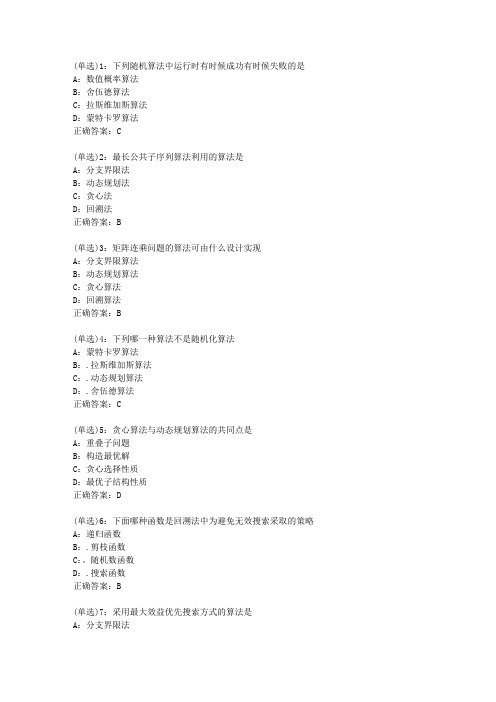
(单选)1:下列随机算法中运行时有时候成功有时候失败的是A:数值概率算法
B:舍伍德算法
C:拉斯维加斯算法
D:蒙特卡罗算法
正确答案:C
(单选)2:最长公共子序列算法利用的算法是
A:分支界限法
B:动态规划法
C:贪心法
D:回溯法
正确答案:B
(单选)3:矩阵连乘问题的算法可由什么设计实现
A:分支界限算法
B:动态规划算法
C:贪心算法
D:回溯算法
正确答案:B
(单选)4:下列哪一种算法不是随机化算法
A:蒙特卡罗算法
B:.拉斯维加斯算法
C:.动态规划算法
D:.舍伍德算法
正确答案:C
(单选)5:贪心算法与动态规划算法的共同点是
A:重叠子问题
B:构造最优解
C:贪心选择性质
D:最优子结构性质
正确答案:D
(单选)6:下面哪种函数是回溯法中为避免无效搜索采取的策略A:递归函数
B:.剪枝函数
C:。
随机数函数
D:.搜索函数
正确答案:B
(单选)7:采用最大效益优先搜索方式的算法是
A:分支界限法。
《数据结构与算法分析》(C++第二版)【美】Clifford A.Shaffer著 课后习题答案 二
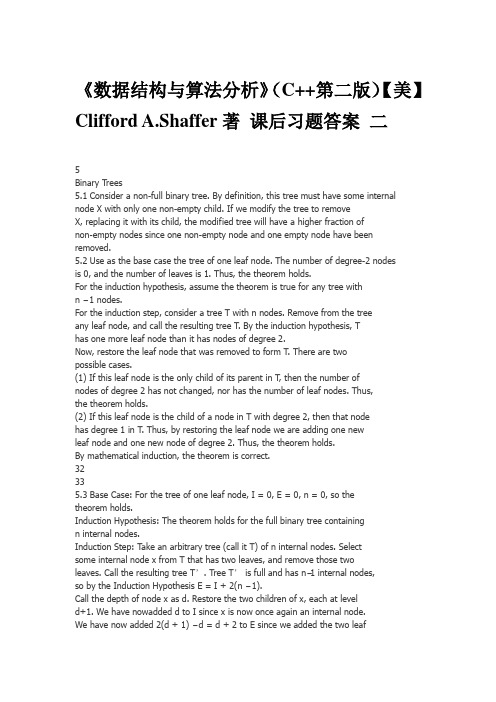
《数据结构与算法分析》(C++第二版)【美】Clifford A.Shaffer著课后习题答案二5Binary Trees5.1 Consider a non-full binary tree. By definition, this tree must have some internalnode X with only one non-empty child. If we modify the tree to removeX, replacing it with its child, the modified tree will have a higher fraction ofnon-empty nodes since one non-empty node and one empty node have been removed.5.2 Use as the base case the tree of one leaf node. The number of degree-2 nodesis 0, and the number of leaves is 1. Thus, the theorem holds.For the induction hypothesis, assume the theorem is true for any tree withn − 1 nodes.For the induction step, consider a tree T with n nodes. Remove from the treeany leaf node, and call the resulting tree T. By the induction hypothesis, Thas one more leaf node than it has nodes of degree 2.Now, restore the leaf node that was removed to form T. There are twopossible cases.(1) If this leaf node is the only child of its parent in T, then the number ofnodes of degree 2 has not changed, nor has the number of leaf nodes. Thus,the theorem holds.(2) If this leaf node is the child of a node in T with degree 2, then that nodehas degree 1 in T. Thus, by restoring the leaf node we are adding one newleaf node and one new node of degree 2. Thus, the theorem holds.By mathematical induction, the theorem is correct.32335.3 Base Case: For the tree of one leaf node, I = 0, E = 0, n = 0, so thetheorem holds.Induction Hypothesis: The theorem holds for the full binary tree containingn internal nodes.Induction Step: Take an arbitrary tree (call it T) of n internal nodes. Selectsome internal node x from T that has two leaves, and remove those twoleaves. Call the resulting tree T’. Tree T’ is full and has n−1 internal nodes,so by the Induction Hypothesis E = I + 2(n − 1).Call the depth of node x as d. Restore the two children of x, each at leveld+1. We have nowadded d to I since x is now once again an internal node.We have now added 2(d + 1) − d = d + 2 to E since we added the two leafnodes, but lost the contribution of x to E. Thus, if before the addition we had E = I + 2(n − 1) (by the induction hypothesis), then after the addition we have E + d = I + d + 2 + 2(n − 1) or E = I + 2n which is correct. Thus,by the principle of mathematical induction, the theorem is correct.5.4 (a) template <class Elem>void inorder(BinNode<Elem>* subroot) {if (subroot == NULL) return; // Empty, do nothingpreorder(subroot->left());visit(subroot); // Perform desired actionpreorder(subroot->right());}(b) template <class Elem>void postorder(BinNode<Elem>* subroot) {if (subroot == NULL) return; // Empty, do nothingpreorder(subroot->left());preorder(subroot->right());visit(subroot); // Perform desired action}5.5 The key is to search both subtrees, as necessary.template <class Key, class Elem, class KEComp>bool search(BinNode<Elem>* subroot, Key K);if (subroot == NULL) return false;if (subroot->value() == K) return true;if (search(subroot->right())) return true;return search(subroot->left());}34 Chap. 5 Binary Trees5.6 The key is to use a queue to store subtrees to be processed.template <class Elem>void level(BinNode<Elem>* subroot) {AQueue<BinNode<Elem>*> Q;Q.enqueue(subroot);while(!Q.isEmpty()) {BinNode<Elem>* temp;Q.dequeue(temp);if(temp != NULL) {Print(temp);Q.enqueue(temp->left());Q.enqueue(temp->right());}}}5.7 template <class Elem>int height(BinNode<Elem>* subroot) {if (subroot == NULL) return 0; // Empty subtreereturn 1 + max(height(subroot->left()),height(subroot->right()));}5.8 template <class Elem>int count(BinNode<Elem>* subroot) {if (subroot == NULL) return 0; // Empty subtreeif (subroot->isLeaf()) return 1; // A leafreturn 1 + count(subroot->left()) +count(subroot->right());}5.9 (a) Since every node stores 4 bytes of data and 12 bytes of pointers, the overhead fraction is 12/16 = 75%.(b) Since every node stores 16 bytes of data and 8 bytes of pointers, the overhead fraction is 8/24 ≈ 33%.(c) Leaf nodes store 8 bytes of data and 4 bytes of pointers; internal nodesstore 8 bytes of data and 12 bytes of pointers. Since the nodes havedifferent sizes, the total space needed for internal nodes is not the sameas for leaf nodes. Students must be careful to do the calculation correctly,taking the weighting into account. The correct formula looks asfollows, given that there are x internal nodes and x leaf nodes.4x + 12x12x + 20x= 16/32 = 50%.(d) Leaf nodes store 4 bytes of data; internal nodes store 4 bytes of pointers. The formula looks as follows, given that there are x internal nodes and35x leaf nodes:4x4x + 4x= 4/8 = 50%.5.10 If equal valued nodes were allowed to appear in either subtree, then during a search for all nodes of a given value, whenever we encounter a node of that value the search would be required to search in both directions.5.11 This tree is identical to the tree of Figure 5.20(a), except that a node with value 5 will be added as the right child of the node with value 2.5.12 This tree is identical to the tree of Figure 5.20(b), except that the value 24 replaces the value 7, and the leaf node that originally contained 24 is removed from the tree.5.13 template <class Key, class Elem, class KEComp>int smallcount(BinNode<Elem>* root, Key K);if (root == NULL) return 0;if (KEComp.gt(root->value(), K))return smallcount(root->leftchild(), K);elsereturn smallcount(root->leftchild(), K) +smallcount(root->rightchild(), K) + 1;5.14 template <class Key, class Elem, class KEComp>void printRange(BinNode<Elem>* root, int low,int high) {if (root == NULL) return;if (KEComp.lt(high, root->val()) // all to leftprintRange(root->left(), low, high);else if (KEComp.gt(low, root->val())) // all to rightprintRange(root->right(), low, high);else { // Must process both childrenprintRange(root->left(), low, high);PRINT(root->value());printRange(root->right(), low, high);}}5.15 The minimum number of elements is contained in the heap with a single node at depth h − 1, for a total of 2h−1 nodes.The maximum number of elements is contained in the heap that has completely filled up level h − 1, for a total of 2h − 1 nodes.5.16 The largest element could be at any leaf node.5.17 The corresponding array will be in the following order (equivalent to level order for the heap):12 9 10 5 4 1 8 7 3 236 Chap. 5 Binary Trees5.18 (a) The array will take on the following order:6 5 3 4 2 1The value 7 will be at the end of the array.(b) The array will take on the following order:7 4 6 3 2 1The value 5 will be at the end of the array.5.19 // Min-heap classtemplate <class Elem, class Comp> class minheap {private:Elem* Heap; // Pointer to the heap arrayint size; // Maximum size of the heapint n; // # of elements now in the heapvoid siftdown(int); // Put element in correct placepublic:minheap(Elem* h, int num, int max) // Constructor{ Heap = h; n = num; size = max; buildHeap(); }int heapsize() const // Return current size{ return n; }bool isLeaf(int pos) const // TRUE if pos a leaf{ return (pos >= n/2) && (pos < n); }int leftchild(int pos) const{ return 2*pos + 1; } // Return leftchild posint rightchild(int pos) const{ return 2*pos + 2; } // Return rightchild posint parent(int pos) const // Return parent position { return (pos-1)/2; }bool insert(const Elem&); // Insert value into heap bool removemin(Elem&); // Remove maximum value bool remove(int, Elem&); // Remove from given pos void buildHeap() // Heapify contents{ for (int i=n/2-1; i>=0; i--) siftdown(i); }};template <class Elem, class Comp>void minheap<Elem, Comp>::siftdown(int pos) { while (!isLeaf(pos)) { // Stop if pos is a leafint j = leftchild(pos); int rc = rightchild(pos);if ((rc < n) && Comp::gt(Heap[j], Heap[rc]))j = rc; // Set j to lesser child’s valueif (!Comp::gt(Heap[pos], Heap[j])) return; // Done37swap(Heap, pos, j);pos = j; // Move down}}template <class Elem, class Comp>bool minheap<Elem, Comp>::insert(const Elem& val) { if (n >= size) return false; // Heap is fullint curr = n++;Heap[curr] = val; // Start at end of heap// Now sift up until curr’s parent < currwhile ((curr!=0) &&(Comp::lt(Heap[curr], Heap[parent(curr)]))) {swap(Heap, curr, parent(curr));curr = parent(curr);}return true;}template <class Elem, class Comp>bool minheap<Elem, Comp>::removemin(Elem& it) { if (n == 0) return false; // Heap is emptyswap(Heap, 0, --n); // Swap max with last valueif (n != 0) siftdown(0); // Siftdown new root valit = Heap[n]; // Return deleted valuereturn true;}38 Chap. 5 Binary Trees// Remove value at specified positiontemplate <class Elem, class Comp>bool minheap<Elem, Comp>::remove(int pos, Elem& it) {if ((pos < 0) || (pos >= n)) return false; // Bad posswap(Heap, pos, --n); // Swap with last valuewhile ((pos != 0) &&(Comp::lt(Heap[pos], Heap[parent(pos)])))swap(Heap, pos, parent(pos)); // Push up if largesiftdown(pos); // Push down if small keyit = Heap[n];return true;}5.20 Note that this summation is similar to Equation 2.5. To solve the summation requires the shifting technique from Chapter 14, so this problem may be too advanced for many students at this time. Note that 2f(n) − f(n) = f(n),but also that:2f(n) − f(n) = n(24+48+616+ ··· +2(log n − 1)n) −n(14+28+316+ ··· +log n − 1n)logn−1i=112i− log n − 1n)= n(1 − 1n− log n − 1n)= n − log n.5.21 Here are the final codes, rather than a picture.l 00h 010i 011e 1000f 1001j 101d 11000a 1100100b 1100101c 110011g 1101k 11139The average code length is 3.234455.22 The set of sixteen characters with equal weight will create a Huffman coding tree that is complete with 16 leaf nodes all at depth 4. Thus, the average code length will be 4 bits. This is identical to the fixed length code. Thus, in this situation, the Huffman coding tree saves no space (and costs no space).5.23 (a) By the prefix property, there can be no character with codes 0, 00, or 001x where “x” stands for any binary string.(b) There must be at least one code with each form 1x, 01x, 000x where“x” could be any binary string (including the empty string).5.24 (a) Q and Z are at level 5, so any string of length n containing only Q’s and Z’s requires 5n bits.(b) O and E are at level 2, so any string of length n containing only O’s and E’s requires 2n bits.(c) The weighted average is5 ∗ 5 + 10 ∗ 4 + 35 ∗ 3 + 50 ∗ 2100bits per character5.25 This is a straightforward modification.// Build a Huffman tree from minheap h1template <class Elem>HuffTree<Elem>*buildHuff(minheap<HuffTree<Elem>*,HHCompare<Elem> >* hl) {HuffTree<Elem> *temp1, *temp2, *temp3;while(h1->heapsize() > 1) { // While at least 2 itemshl->removemin(temp1); // Pull first two treeshl->removemin(temp2); // off the heaptemp3 = new HuffTree<Elem>(temp1, temp2);hl->insert(temp3); // Put the new tree back on listdelete temp1; // Must delete the remnantsdelete temp2; // of the trees we created}return temp3;}6General Trees6.1 The following algorithm is linear on the size of the two trees. // Return TRUE iff t1 and t2 are roots of identical// general treestemplate <class Elem>bool Compare(GTNode<Elem>* t1, GTNode<Elem>* t2) { GTNode<Elem> *c1, *c2;if (((t1 == NULL) && (t2 != NULL)) ||((t2 == NULL) && (t1 != NULL)))return false;if ((t1 == NULL) && (t2 == NULL)) return true;if (t1->val() != t2->val()) return false;c1 = t1->leftmost_child();c2 = t2->leftmost_child();while(!((c1 == NULL) && (c2 == NULL))) {if (!Compare(c1, c2)) return false;if (c1 != NULL) c1 = c1->right_sibling();if (c2 != NULL) c2 = c2->right_sibling();}}6.2 The following algorithm is Θ(n2).// Return true iff t1 and t2 are roots of identical// binary treestemplate <class Elem>bool Compare2(BinNode<Elem>* t1, BinNode<Elem* t2) { BinNode<Elem> *c1, *c2;if (((t1 == NULL) && (t2 != NULL)) ||((t2 == NULL) && (t1 != NULL)))return false;if ((t1 == NULL) && (t2 == NULL)) return true;4041if (t1->val() != t2->val()) return false;if (Compare2(t1->leftchild(), t2->leftchild())if (Compare2(t1->rightchild(), t2->rightchild())return true;if (Compare2(t1->leftchild(), t2->rightchild())if (Compare2(t1->rightchild(), t2->leftchild))return true;return false;}6.3 template <class Elem> // Print, postorder traversalvoid postprint(GTNode<Elem>* subroot) {for (GTNode<Elem>* temp = subroot->leftmost_child();temp != NULL; temp = temp->right_sibling())postprint(temp);if (subroot->isLeaf()) cout << "Leaf: ";else cout << "Internal: ";cout << subroot->value() << "\n";}6.4 template <class Elem> // Count the number of nodesint gencount(GTNode<Elem>* subroot) {if (subroot == NULL) return 0int count = 1;GTNode<Elem>* temp = rt->leftmost_child();while (temp != NULL) {count += gencount(temp);temp = temp->right_sibling();}return count;}6.5 The Weighted Union Rule requires that when two parent-pointer trees are merged, the smaller one’s root becomes a child of the larger one’s root. Thus, we need to keep track of the number of nodes in a tree. To do so, modify the node array to store an integer value with each node. Initially, each node isin its own tree, so the weights for each node begin as 1. Whenever we wishto merge two trees, check the weights of the roots to determine which has more nodes. Then, add to the weight of the final root the weight of the new subtree.6.60 1 2 3 4 5 6 7 8 9 10 11 12 13 14 15-1 0 0 0 0 0 0 6 0 0 0 9 0 0 12 06.7 The resulting tree should have the following structure:42 Chap. 6 General TreesNode 0 1 2 3 4 5 6 7 8 9 10 11 12 13 14 15Parent 4 4 4 4 -1 4 4 0 0 4 9 9 9 12 9 -16.8 For eight nodes labeled 0 through 7, use the following series of equivalences: (0, 1) (2, 3) (4, 5) (6, 7) (4 6) (0, 2) (4 0)This requires checking fourteen parent pointers (two for each equivalence),but none are actually followed since these are all roots. It is possible todouble the number of parent pointers checked by choosing direct children ofroots in each case.6.9 For the “lists of Children” representation, every node stores a data value and a pointer to its list of children. Further, every child (every node except the root)has a record associated with it containing an index and a pointer. Indicatingthe size of the data value as D, the size of a pointer as P and the size of anindex as I, the overhead fraction is3P + ID + 3P + I.For the “Left Child/Right Sibling” representation, every node stores three pointers and a data value, for an overhead fraction of3PD + 3P.The first linked representation of Section 6.3.3 stores with each node a datavalue and a size field (denoted by S). Each child (every node except the root)also has a pointer pointing to it. The overhead fraction is thusS + PD + S + Pmaking it quite efficient.The second linked representation of Section 6.3.3 stores with each node adata value and a pointer to the list of children. Each child (every node exceptthe root) has two additional pointers associated with it to indicate its placeon the parent’s linked list. Thus, the overhead fraction is3PD + 3P.6.10 template <class Elem>BinNode<Elem>* convert(GTNode<Elem>* genroot) {if (genroot == NULL) return NULL;43GTNode<Elem>* gtemp = genroot->leftmost_child();btemp = new BinNode(genroot->val(), convert(gtemp),convert(genroot->right_sibling()));}6.11 • Parent(r) = (r − 1)/k if 0 < r < n.• Ith child(r) = kr + I if kr +I < n.• Left sibling(r) = r − 1 if r mod k = 1 0 < r < n.• Right sibling(r) = r + 1 if r mod k = 0 and r + 1 < n.6.12 (a) The overhead fraction is4(k + 1)4 + 4(k + 1).(b) The overhead fraction is4k16 + 4k.(c) The overhead fraction is4(k + 2)16 + 4(k + 2).(d) The overhead fraction is2k2k + 4.6.13 Base Case: The number of leaves in a non-empty tree of 0 internal nodes is (K − 1)0 + 1 = 1. Thus, the theorem is correct in the base case.Induction Hypothesis: Assume that the theorem is correct for any full Karytree containing n internal nodes.Induction Step: Add K children to an arbitrary leaf node of the tree withn internal nodes. This new tree now has 1 more internal node, and K − 1more leaf nodes, so theorem still holds. Thus, the theorem is correct, by the principle of Mathematical Induction.6.14 (a) CA/BG///FEDD///H/I//(b) CA/BG/FED/H/I6.15 X|P-----| | |C Q R---| |V M44 Chap. 6 General Trees6.16 (a) // Use a helper function with a pass-by-reference// variable to indicate current position in the// node list.template <class Elem>BinNode<Elem>* convert(char* inlist) {int curr = 0;return converthelp(inlist, curr);}// As converthelp processes the node list, curr is// incremented appropriately.template <class Elem>BinNode<Elem>* converthelp(char* inlist,int& curr) {if (inlist[curr] == ’/’) {curr++;return NULL;}BinNode<Elem>* temp = new BinNode(inlist[curr++], NULL, NULL);temp->left = converthelp(inlist, curr);temp->right = converthelp(inlist, curr);return temp;}(b) // Use a helper function with a pass-by-reference // variable to indicate current position in the// node list.template <class Elem>BinNode<Elem>* convert(char* inlist) {int curr = 0;return converthelp(inlist, curr);}// As converthelp processes the node list, curr is// incremented appropriately.template <class Elem>BinNode<Elem>* converthelp(char* inlist,int& curr) {if (inlist[curr] == ’/’) {curr++;return NULL;}BinNode<Elem>* temp =new BinNode<Elem>(inlist[curr++], NULL, NULL);if (inlist[curr] == ’\’’) return temp;45curr++ // Eat the internal node mark.temp->left = converthelp(inlist, curr);temp->right = converthelp(inlist, curr);return temp;}(c) // Use a helper function with a pass-by-reference// variable to indicate current position in the// node list.template <class Elem>GTNode<Elem>* convert(char* inlist) {int curr = 0;return converthelp(inlist, curr);}// As converthelp processes the node list, curr is// incremented appropriately.template <class Elem>GTNode<Elem>* converthelp(char* inlist,int& curr) {if (inlist[curr] == ’)’) {curr++;return NULL;}GTNode<Elem>* temp =new GTNode<Elem>(inlist[curr++]);if (curr == ’)’) {temp->insert_first(NULL);return temp;}temp->insert_first(converthelp(inlist, curr));while (curr != ’)’)temp->insert_next(converthelp(inlist, curr));curr++;return temp;}6.17 The Huffman tree is a full binary tree. To decode, we do not need to know the weights of nodes, only the letter values stored in the leaf nodes. Thus, we can use a coding much like that of Equation 6.2, storing only a bit mark for internal nodes, and a bit mark and letter value for leaf nodes.7Internal Sorting7.1 Base Case: For the list of one element, the double loop is not executed and the list is not processed. Thus, the list of one element remains unaltered and is sorted.Induction Hypothesis: Assume that the list of n elements is sorted correctlyby Insertion Sort.Induction Step: The list of n + 1 elements is processed by first sorting thetop n elements. By the induction hypothesis, this is done correctly. The final pass of the outer for loop will process the last element (call it X). This isdone by the inner for loop, which moves X up the list until a value smallerthan that of X is encountered. At this point, X has been properly insertedinto the sorted list, leaving the entire collection of n + 1 elements correctly sorted. Thus, by the principle of Mathematical Induction, the theorem is correct.7.2 void StackSort(AStack<int>& IN) {AStack<int> Temp1, Temp2;while (!IN.isEmpty()) // Transfer to another stackTemp1.push(IN.pop());IN.push(Temp1.pop()); // Put back one elementwhile (!Temp1.isEmpty()) { // Process rest of elemswhile (IN.top() > Temp1.top()) // Find elem’s placeTemp2.push(IN.pop());IN.push(Temp1.pop()); // Put the element inwhile (!Temp2.isEmpty()) // Put the rest backIN.push(Temp2.pop());}}46477.3 The revised algorithm will work correctly, and its asymptotic complexity will remain Θ(n2). However, it will do about twice as many comparisons, since it will compare adjacent elements within the portion of the list already knownto be sorted. These additional comparisons are unproductive.7.4 While binary search will find the proper place to locate the next element, it will still be necessary to move the intervening elements down one position in the array. This requires the same number of operations as a sequential search. However, it does reduce the number of element/element comparisons, and may be somewhat faster by a constant factor since shifting several elements may be more efficient than an equal number of swap operations.7.5 (a) template <class Elem, class Comp>void selsort(Elem A[], int n) { // Selection Sortfor (int i=0; i<n-1; i++) { // Select i’th recordint lowindex = i; // Remember its indexfor (int j=n-1; j>i; j--) // Find least valueif (Comp::lt(A[j], A[lowindex]))lowindex = j; // Put it in placeif (i != lowindex) // Add check for exerciseswap(A, i, lowindex);}}(b) There is unlikely to be much improvement; more likely the algorithmwill slow down. This is because the time spent checking (n times) isunlikely to save enough swaps to make up.(c) Try it and see!7.6 • Insertion Sort is stable. A swap is done only if the lower element’svalue is LESS.• Bubble Sort is stable. A swap is done only if the lower element’s valueis LESS.• Selection Sort is NOT stable. The new low value is set only if it isactually less than the previous one, but the direction of the search isfrom the bottom of the array. The algorithm will be stable if “less than”in the check becomes “less than or equal to” for selecting the low key position.• Shell Sort is NOT stable. The sublist sorts are done independently, andit is quite possible to swap an element in one sublist ahead of its equalvalue in another sublist. Once they are in the same sublist, they willretain this (incorrect) relationship.• Quick-sort is NOT stable. After selecting the pivot, it is swapped withthe last element. This action can easily put equal records out of place.48 Chap. 7 Internal Sorting• Conceptually (in particular, the linked list version) Mergesort is stable.The array implementations are NOT stable, since, given that the sublistsare stable, the merge operation will pick the element from the lower listbefore the upper list if they are equal. This is easily modified to replace“less than” with “less than or equal to.”• Heapsort is NOT stable. Elements in separate sides of the heap are processed independently, and could easily become out of relative order.• Binsort is stable. Equal values that come later are appended to the list.• Radix Sort is stable. While the processing is from bottom to top, thebins are also filled from bottom to top, preserving relative order.7.7 In the worst case, the stack can store n records. This can be cut to log n in the worst case by putting the larger partition on FIRST, followed by the smaller. Thus, the smaller will be processed first, cutting the size of the next stacked partition by at least half.7.8 Here is how I derived a permutation that will give the desired (worst-case) behavior:a b c 0 d e f g First, put 0 in pivot index (0+7/2),assign labels to the other positionsa b c g d e f 0 First swap0 b c g d e f a End of first partition pass0 b c g 1 e f a Set d = 1, it is in pivot index (1+7/2)0 b c g a e f 1 First swap0 1 c g a e f b End of partition pass0 1 c g 2 e f b Set a = 2, it is in pivot index (2+7/2)0 1 c g b e f 2 First swap0 1 2 g b e f c End of partition pass0 1 2 g b 3 f c Set e = 3, it is in pivot index (3+7/2)0 1 2 g b c f 3 First swap0 1 2 3 b c f g End of partition pass0 1 2 3 b 4 f g Set c = 4, it is in pivot index (4+7/2)0 1 2 3 b g f 4 First swap0 1 2 3 4 g f b End of partition pass0 1 2 3 4 g 5 b Set f = 5, it is in pivot index (5+7/2)0 1 2 3 4 g b 5 First swap0 1 2 3 4 5 b g End of partition pass0 1 2 3 4 5 6 g Set b = 6, it is in pivot index (6+7/2)0 1 2 3 4 5 g 6 First swap0 1 2 3 4 5 6 g End of parition pass0 1 2 3 4 5 6 7 Set g = 7.Plugging the variable assignments into the original permutation yields:492 6 4 0 13 5 77.9 (a) Each call to qsort costs Θ(i log i). Thus, the total cost isni=1i log i = Θ(n2 log n).(b) Each call to qsort costs Θ(n log n) for length(L) = n, so the totalcost is Θ(n2 log n).7.10 All that we need to do is redefine the comparison test to use strcmp. The quicksort algorithm itself need not change. This is the advantage of paramerizing the comparator.7.11 For n = 1000, n2 = 1, 000, 000, n1.5 = 1000 ∗√1000 ≈ 32, 000, andn log n ≈ 10, 000. So, the constant factor for Shellsort can be anything less than about 32 times that of Insertion Sort for Shellsort to be faster. The constant factor for Shellsort can be anything less than about 100 times thatof Insertion Sort for Quicksort to be faster.7.12 (a) The worst case occurs when all of the sublists are of size 1, except for one list of size i − k + 1. If this happens on each call to SPLITk, thenthe total cost of the algorithm will be Θ(n2).(b) In the average case, the lists are split into k sublists of roughly equal length. Thus, the total cost is Θ(n logk n).7.13 (This question comes from Rawlins.) Assume that all nuts and all bolts havea partner. We use two arrays N[1..n] and B[1..n] to represent nuts and bolts. Algorithm 1Using merge-sort to solve this problem.First, split the input into n/2 sub-lists such that each sub-list contains twonuts and two bolts. Then sort each sub-lists. We could well come up with apair of nuts that are both smaller than either of a pair of bolts. In that case,all you can know is something like:N1, N2。
算法设计与分析第二版课后习题及解答(可编辑)
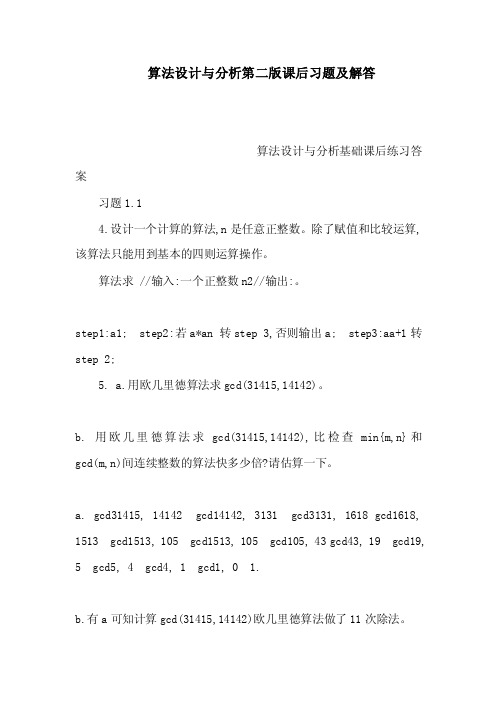
算法设计与分析第二版课后习题及解答算法设计与分析基础课后练习答案习题1.14.设计一个计算的算法,n是任意正整数。
除了赋值和比较运算,该算法只能用到基本的四则运算操作。
算法求 //输入:一个正整数n2//输出:。
step1:a1; step2:若a*an 转step 3,否则输出a; step3:aa+1转step 2;5. a.用欧几里德算法求gcd(31415,14142)。
b. 用欧几里德算法求gcd(31415,14142),比检查min{m,n}和gcd(m,n)间连续整数的算法快多少倍?请估算一下。
a. gcd31415, 14142 gcd14142, 3131 gcd3131, 1618 gcd1618, 1513 gcd1513, 105 gcd1513, 105 gcd105, 43 gcd43, 19 gcd19, 5 gcd5, 4 gcd4, 1 gcd1, 0 1.b.有a可知计算gcd(31415,14142)欧几里德算法做了11次除法。
连续整数检测算法在14142每次迭代过程中或者做了一次除法,或者两次除法,因此这个算法做除法的次数鉴于1?14142 和 2?14142之间,所以欧几里德算法比此算法快1?14142/11 ≈1300 与2?14142/11 ≈ 2600 倍之间。
6.证明等式gcdm,ngcdn,m mod n对每一对正整数m,n都成立.Hint:根据除法的定义不难证明:如果d整除u和v, 那么d一定能整除u±v;如果d整除u,那么d也能够整除u的任何整数倍ku.对于任意一对正整数m,n,若d能整除m和n,那么d一定能整除n和rm mod nm-qn;显然,若d能整除n和r,也一定能整除mr+qn和n。
数对m,n和n,r具有相同的公约数的有限非空集,其中也包括了最大公约数。
故gcdm,ngcdn,r7.对于第一个数小于第二个数的一对数字,欧几里得算法将会如何处理?该算法在处理这种输入的过程中,上述情况最多会发生几次?Hint:对于任何形如0mn的一对数字,Euclid算法在第一次叠代时交换m和n, 即gcdm,ngcdn,m并且这种交换处理只发生一次.8.a.对于所有1≤m,n≤10的输入, Euclid算法最少要做几次除法?1次b. 对于所有1≤m,n≤10的输入, Euclid算法最多要做几次除法?5次gcd5,8习题1.21.农夫过河P?农夫W?狼 G?山羊 C?白菜2.过桥问题1,2,5,10---分别代表4个人, f?手电筒4. 对于任意实系数a,b,c, 某个算法能求方程ax^2+bx+c0的实根,写出上述算法的伪代码可以假设sqrtx是求平方根的函数算法Quadratica,b,c//求方程ax^2+bx+c0的实根的算法//输入:实系数a,b,c//输出:实根或者无解信息If a≠0D←b*b-4*a*cIf D0temp←2*ax1←-b+sqrtD/tempx2←-b-sqrtD/tempreturn x1,x2else if D0 return ?b/2*ael se return “no real roots”else //a0if b≠0 return ?c/belse //ab0if c0 return “no real numbers”else return “no real roots”5. 描述将十进制整数表达为二进制整数的标准算法a.用文字描述b.用伪代码描述解答:a.将十进制整数转换为二进制整数的算法输入:一个正整数n输出:正整数n相应的二进制数第一步:用n除以2,余数赋给Kii0,1,2,商赋给n第二步:如果n0,则到第三步,否则重复第一步第三步:将Ki按照i从高到低的顺序输出b.伪代码算法 DectoBinn//将十进制整数n转换为二进制整数的算法//输入:正整数n//输出:该正整数相应的二进制数,该数存放于数组Bin[1n]中i1while n!0 doBin[i]n%2;nintn/2;i++;while i!0 doprint Bin[i];i--;9.考虑下面这个算法,它求的是数组中大小相差最小的两个元素的差.算法略对这个算法做尽可能多的改进.算法 MinDistanceA[0..n-1]//输入:数组A[0..n-1]//输出:the smallest distance d between two of its elements 习题1.3考虑这样一个排序算法,该算法对于待排序的数组中的每一个元素,计算比它小的元素个数,然后利用这个信息,将各个元素放到有序数组的相应位置上去.a.应用该算法对列表”60,35,81,98,14,47”排序b.该算法稳定吗?c.该算法在位吗?解:a. 该算法对列表”60,35,81,98,14,47”排序的过程如下所示:b.该算法不稳定.比如对列表”2,2*”排序c.该算法不在位.额外空间for S and Count[]4.古老的七桥问题第2章习题2.17.对下列断言进行证明:如果是错误的,请举例a. 如果tn∈Ogn,则gn∈Ωtnb.α0时,Θαgn Θgn解:a这个断言是正确的。
【北语网院】18秋《算法与数据分析》作业_2(答案)

【北京语言大学】18秋《算法与数据分析》作业_2试卷总分:100 得分:100第1题,0-1背包问题的回溯算法所需的计算时间为A、O(n2n)B、O(nlogn)C、O(2n)D、O(n)正确答案:第2题,<span style="font-size:14px;font-family:宋体">动态规划算法的基本要素为</span>A、<span style="font-size:14px;font-family:宋体">最优子结构性质与贪心选择性质</span>B、<span style="font-size:14px;font-family:宋体">重叠子问题性质与贪心选择性质</span>C、<span style="font-size:14px;font-family:宋体">最优子结构性质与重叠子问题性质</span>D、<span style="font-size:14px;font-family:宋体">预排序与递归调用</span>正确答案:第3题,实现合并排序利用的算法是A、分治策略B、动态规划法C、贪心法D、回溯法正确答案:第4题,合并排序算法是利用A、分治策略B、动态规划法C、贪心法D、回溯法正确答案:第5题,实现棋盘覆盖算法利用的算法是A、分治法B、动态规划法C、贪心法D、回溯法正确答案:第6题,实现最长公共子序列利用的算法是A、分治策略B、动态规划法C、贪心法D、回溯法正确答案:第7题,最长公共子序列算法利用的算法是A、分支界限法B、动态规划法C、贪心法D、回溯法正确答案:第8题,在下列算法中有时找不到问题解的是A、蒙特卡罗算法B、拉斯维加斯算法C、舍伍德算法D、数值概率算法正确答案:第9题,回溯法解旅行售货员问题时的解空间树是A、子集树B、排列树C、深度优先生成树D、广度优先生成树正确答案:第10题,下面是贪心算法的基本要素的是A、重叠子问题B、构造最优解C、贪心选择性质D、定义最优解正确答案:第11题,回溯法是一种既带有系统性又带有跳跃性的搜索算法。
北京语言大学智慧树知到“计算机科学与技术”《算法与数据分析》网课测试题答案2
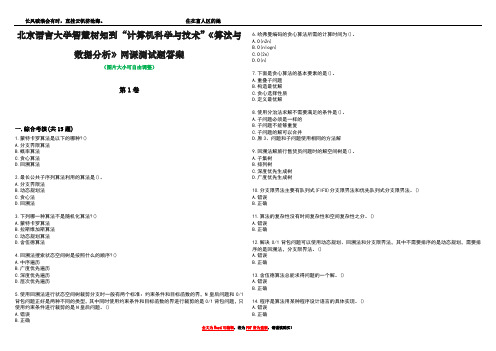
北京语言大学智慧树知到“计算机科学与技术”《算法与数据分析》网课测试题答案(图片大小可自由调整)第1卷一.综合考核(共15题)1.蒙特卡罗算法是以下的哪种?()A.分支界限算法B.概率算法C.贪心算法D.回溯算法2.最长公共子序列算法利用的算法是()。
A.分支界限法B.动态规划法C.贪心法D.回溯法3.下列哪一种算法不是随机化算法?()A.蒙特卡罗算法B.拉斯维加斯算法C.动态规划算法D.舍伍德算法4.回溯法搜索状态空间树是按照什么的顺序?()A.中序遍历B.广度优先遍历C.深度优先遍历D.层次优先遍历5.使用回溯法进行状态空间树裁剪分支时一般有两个标准:约束条件和目标函数的界,N皇后问题和0/1背包问题正好是两种不同的类型,其中同时使用约束条件和目标函数的界进行裁剪的是0/1背包问题,只使用约束条件进行裁剪的是N皇后问题。
()A.错误B.正确6.哈弗曼编码的贪心算法所需的计算时间为()。
A.O(n2n)B.O(nlogn)C.O(2n)D.O(n)7.下面是贪心算法的基本要素的是()。
A.重叠子问题B.构造最优解C.贪心选择性质D.定义最优解8.使用分治法求解不需要满足的条件是()。
A.子问题必须是一样的B.子问题不能够重复C.子问题的解可以合并D.原3、问题和子问题使用相同的方法解9.回溯法解旅行售货员问题时的解空间树是()。
A.子集树B.排列树C.深度优先生成树D.广度优先生成树10.分支限界法主要有队列式(FIFO)分支限界法和优先队列式分支限界法。
()A.错误B.正确11.算法的复杂性没有时间复杂性和空间复杂性之分。
()A.错误B.正确12.解决0/1背包问题可以使用动态规划、回溯法和分支限界法,其中不需要排序的是动态规划,需要排序的是回溯法,分支限界法。
()A.错误B.正确13.舍伍德算法总能求得问题的一个解。
()A.错误B.正确14.程序是算法用某种程序设计语言的具体实现。
()A.错误B.正确15.计算一个算法时间复杂度通常可以计算循环次数、基本操作的频率或计算步。
【奥鹏】[北语]《算法与数据分析》作业2‖满分参考
![【奥鹏】[北语]《算法与数据分析》作业2‖满分参考](https://img.taocdn.com/s3/m/d0e9e3e5c5da50e2534d7fbe.png)
《算法与数据分析》作业2以下不可以使用分治法求解的是选项A:棋盘覆盖问题选项B:选择问题选项C:归并排序选项D:0/1背包问题正确选项 :D实现最长公共子序列利用的算法是选项A:分治策略选项B:动态规划法选项C:贪心法选项D:回溯法正确选项 :B广度优先是什么的一种搜索方式选项A:分支界限法选项B:动态规划法选项C:贪心法选项D:回溯法正确选项 :A下列哪一种算法是随机化算法选项A:贪心算法选项B:.回溯法选项C:.动态规划算法选项D:.舍伍德算法正确选项 :D实现合并排序利用的算法是选项A:分治策略选项B:动态规划法选项C:贪心法选项D:回溯法正确选项 :A下面是贪心算法的基本要素的是选项A:重叠子问题选项B:构造最优解选项C:贪心选择性质选项D:定义最优解正确选项 :C下面关于NP问题说法正确的是选项A:NP问题都是不可能解决的问题选项B:P类问题包含在NP类问题中选项C:NP完全问题是P类问题的子集选项D:NP类问题包含在P类问题中正确选项 :B下列算法中不能解决0/1背包问题的是选项A:贪心法选项B:动态规划选项C:回溯法选项D:分支限界法正确选项 :A下列是动态规划算法基本要素的是选项A:定义最优解选项B:构造最优解选项C:算出最优解选项D:子问题重叠性质正确选项 :D衡量一个算法好坏的标准是选项A:运行速度快选项B:占用空间少选项C:时间复杂度低选项D:代码短正确选项 :C矩阵连乘问题的算法可由动态规划设计实现。
选项A:错误选项B:正确正确选项 :B回溯法搜索解空间树时,常用的两种剪枝函数为约束函数和限界函数。
选项A:错误选项B:正确正确选项 :B大整数乘积算法是用分治法来设计的。
选项A:错误选项B:正确正确选项 :B。
东师《算法分析与设计》20春在线作业2答案19

(单选题)1: 图中有关路径的定义是()。
A: 由顶点和相邻顶点序偶构成的边所形成的序列
B: 由不同顶点所形成的序列
C: 由不同边所形成的序列
D: 上述定义都不是
正确答案: A
(单选题)2: ()是一个基本完整的开发工具集,它包括了整个软件生命周期中所需要的大部分工具,如UML工具、代码管控工具、集成开发环境等等。
A: VS
B: VM
C: Dev-C++
D: IDE
正确答案: A
(单选题)3: 下列数据结构中,属于非线性结构的是()。
A: 循环队列
B: 带链队列
C: 二叉树
D: 带链栈
正确答案: C
(单选题)4: 下列叙述中正确的是()。
A: 顺序存储结构的存储一定是连续的,链式存储结构的存储空间不一定是连续的
B: 顺序存储结构只针对线性结构,链式存储结构只针对非线性结构
C: 顺序存储结构能存储有序表,链式存储结构不能存储有序表
D: 链式存储结构比顺序存储结构节省存储空间
正确答案: A
(单选题)5: 十六进制中最大的数码是()。
A: 16
B: 15
C: F
D: E
正确答案: C
(单选题)6: 二进制,就表示某一位置上的数运算时是逢()进一位。
A: 2
B: 8
C: 9
D: 10
正确答案: A
(单选题)7: 在程序代码编辑框外(一般都是程序代码的最左侧)双击,就成功设置了一个断。
北航《算法与数据结构》在线作业二
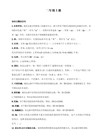
A. 分支结点数加1
B. 单分支结点数加1
C. 双分支结点数加1
D. 双分支结点数减1
满分:4 分
25. 某二叉树结点的前序序列为E、A、C、B、D、G、F,中序遍历为A、B、C、D、E、F、G。 该二叉树结点的后序序列为 ( )。
A. B,D,C,A,F,G,E
B. 63
C. 32
D. 31
满分:4 分
15. 如果待排序序列中两个数据元素具有相同的值,在排序后它们的位置发生颠倒,则称该排序是不稳定的。下列选项中,()就是不稳定的排序方法。
A. 起泡排序
B. 归并排序
C. 直接插入法排序
D. 简单选择排序
满分:4 分
D. 'DATA'
满分:4 分
2. 某二叉树的先序序列和后序序列正好相反,则该二叉树一定是( )的二叉树。
A. 空或只有一个结点高度等于其结点数
B. 任一结点无左孩子
C. 任一结点无右孩子
满分:4 分
3. 设有50行60列的二维数组A[50][60],其元素长度为4字节,按行优先顺序存储,基地址为200,则元素A[18][25]的存储地址为()。
C. 附加设施,如为便于运算实现而设置的“哑结点”等等
D. 一种存储结构可以在两个级别上讨论。其一是机器级,其二是语言级
满分:4 分
9. n个顶点的连通图至少有( )条边。
A. n-1
B. n
C. n+1
D. 0
满分:4 分
10. 排序方法中,从未排序序列中依次取出元素与己排序序列(初始时为空)中的元素进行比较,将其放入己排序序列的正确位置上的方法,称为()
福师20年秋数据结构概论在线作业二【标准答案】
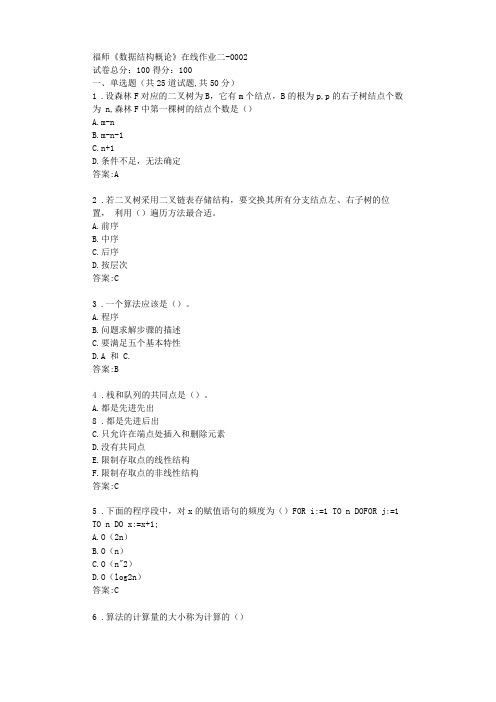
福师《数据结构概论》在线作业二-0002试卷总分:100得分:100一、单选题(共25道试题,共50分)1.设森林F对应的二叉树为B,它有m个结点,B的根为p,p的右子树结点个数为 n,森林F中第一棵树的结点个数是()A.m-nB.m-n-1C.n+1D.条件不足,无法确定答案:A2.若二叉树采用二叉链表存储结构,要交换其所有分支结点左、右子树的位置,利用()遍历方法最合适。
A.前序B.中序C.后序D.按层次答案:C3.一个算法应该是()。
A.程序B.问题求解步骤的描述C.要满足五个基本特性D.A 和 C.答案:B4.栈和队列的共同点是()。
A.都是先进先出8.都是先进后出C.只允许在端点处插入和删除元素D.没有共同点E.限制存取点的线性结构F.限制存取点的非线性结构答案:C5.下面的程序段中,对x的赋值语句的频度为()FOR i:=1 TO n DOFOR j:=1 TO n DO x:=x+1;A.O(2n)B.O(n)C.O(n"2)D.O(log2n)答案:C6.算法的计算量的大小称为计算的()A.效率B.复杂性C.现实性D.难度答案:B7.对于栈操作数据的原则是()A.先进先出8.后进先出C.后进后出D.不分顺序答案:B8.下列表达式中结果不是日期型的是?A.CT0D("2000/10/01")B.「99/10/01}+365C.VAL("2000/10/01")D.DATE()答案:C9.关键路径是事件结点网络中()A.从源点到汇点的最长路径B.从源点到汇点的最短路径C.最长回路D.最短回路答案:A10.就平均性能而言,目前最好的内排序方法是()排序法。
A.冒泡B.希尔插入C.交换D.快速答案:D11.栈和队都是()A.顺序存储的B.线性结构C.链式存储的D.非线性结构答案:B12.关系数据库中,实现实体之间的联系是通过表与表之间的?A.公共索引B.公共存储C.公共元组D.公共属性答案:D13.下列关于候选键的说法中错误的是?A.键是惟一标识实体的属性集B.候选键能惟一决定一个元组C.能惟一决定一个元组的属性集是候选键D.候选键中的属性均为主属性答案:C14.假设以行序为主序存储二维数组A=array[1..100,1..100],设每个数据元素占2个存储单元,基地址为10,则LOC[5,5]=()A.808B.818C.1010D.1020答案:B15.链表不具有的特点是()儿插入、删除不需要移动元素B.可随机访问任一元素C.不必事先估计存储空间D.所需空间与线性长度成正比答案:B16.若要求尽可能快地对序列进行稳定的排序,则应选(A.快速排序B.归并排序C.冒泡排序D.堆答案:B17.下面关于关系数据模型的说法,正确的是哪一项?A.只能表示实体间的1:1联系B.只能表示实体间的l:n联系C.只能表示实体间的m:n联系D.可以表示实体间的上述三种联系答案:D18.若长度为n的线性表采用顺序存储结构,在其第i个位置插入一个新元素的算法的时间复杂度为()(1<=i<=n+1)。
北语网院20春《算法与数据分析》作业_4答案
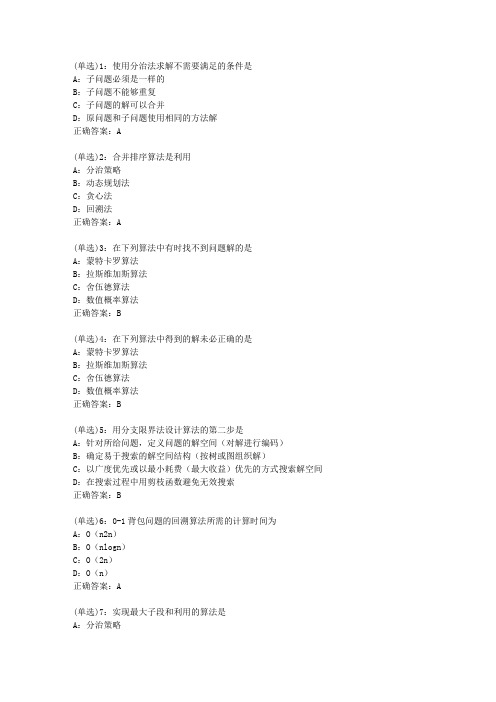
(单选)1:使用分治法求解不需要满足的条件是
A:子问题必须是一样的
B:子问题不能够重复
C:子问题的解可以合并
D:原问题和子问题使用相同的方法解
正确答案:A
(单选)2:合并排序算法是利用
A:分治策略
B:动态规划法
C:贪心法
D:回溯法
正确答案:A
(单选)3:在下列算法中有时找不到问题解的是
A:蒙特卡罗算法
B:拉斯维加斯算法
C:舍伍德算法
D:数值概率算法
正确答案:B
(单选)4:在下列算法中得到的解未必正确的是
A:蒙特卡罗算法
B:拉斯维加斯算法
C:舍伍德算法
D:数值概率算法
正确答案:B
(单选)5:用分支限界法设计算法的第二步是
A:针对所给问题,定义问题的解空间(对解进行编码)
B:确定易于搜索的解空间结构(按树或图组织解)
C:以广度优先或以最小耗费(最大收益)优先的方式搜索解空间D:在搜索过程中用剪枝函数避免无效搜索
正确答案:B
(单选)6:0-1背包问题的回溯算法所需的计算时间为
A:O(n2n)
B:O(nlogn)
C:O(2n)
D:O(n)
正确答案:A
(单选)7:实现最大子段和利用的算法是
A:分治策略。
东师软件工程20秋在线作业2答案_22290
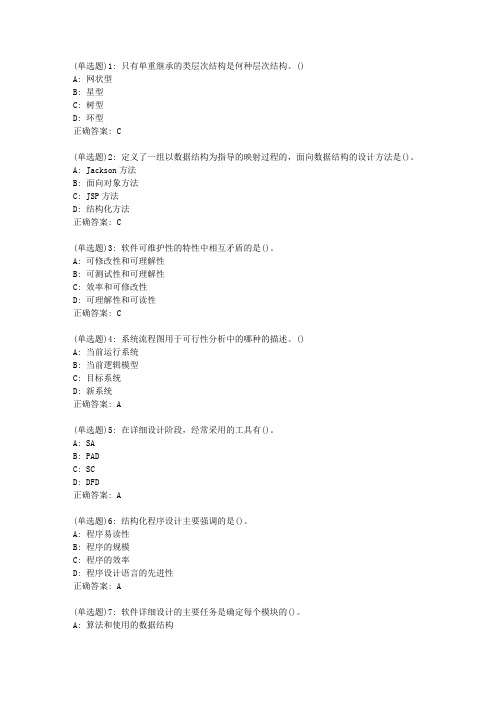
(单选题)1: 只有单重继承的类层次结构是何种层次结构。
()
A: 网状型
B: 星型
C: 树型
D: 环型
正确答案: C
(单选题)2: 定义了一组以数据结构为指导的映射过程的,面向数据结构的设计方法是()。
A: Jackson方法
B: 面向对象方法
C: JSP方法
D: 结构化方法
正确答案: C
(单选题)3: 软件可维护性的特性中相互矛盾的是()。
A: 可修改性和可理解性
B: 可测试性和可理解性
C: 效率和可修改性
D: 可理解性和可读性
正确答案: C
(单选题)4: 系统流程图用于可行性分析中的哪种的描述。
()
A: 当前运行系统
B: 当前逻辑模型
C: 目标系统
D: 新系统
正确答案: A
(单选题)5: 在详细设计阶段,经常采用的工具有()。
A: SA
B: PAD
C: SC
D: DFD
正确答案: A
(单选题)6: 结构化程序设计主要强调的是()。
A: 程序易读性
B: 程序的规模
C: 程序的效率
D: 程序设计语言的先进性
正确答案: A
(单选题)7: 软件详细设计的主要任务是确定每个模块的()。
A: 算法和使用的数据结构。
北语20秋《算法与数据分析》作业2-辅导答案

[北语]20秋《算法与数据分析》作业2
试卷总分:100 得分:100
一、单选题 (共 10 道试题,共 50 分)
1.采用贪心算法的最优装载问题的主要计算量在于将集装箱依其重量从小到大排序,故算法的时间复杂度为
A.O(n2n)
B.O(nlogn)
C.O(2n)
D.O(n)
【正确参考选项是】:B
2.在下列算法中有时找不到问题解的是
A.蒙特卡罗算法
B.拉斯维加斯算法
C.舍伍德算法
D.数值概率算法
【正确参考选项是】:B
3.最长公共子序列算法利用的算法是
A.分支界限法
B.动态规划法
C.贪心法
D.回溯法
【正确参考选项是】:B
4.下列算法中通常以深度优先方式系统搜索问题解的是
A.备忘录法
B.动态规划法
C.贪心法
D.回溯法
【正确参考选项是】:D
5.Strassen矩阵乘法是利用什么实现的算法
A.分治策略
B.动态规划法
C.贪心法
D.回溯法
【正确参考选项是】:A
6.以深度优先方式系统搜索问题解的算法称为
A.分支界限算法
B.概率算法。
南开24年秋季《数据分析》作业参考一
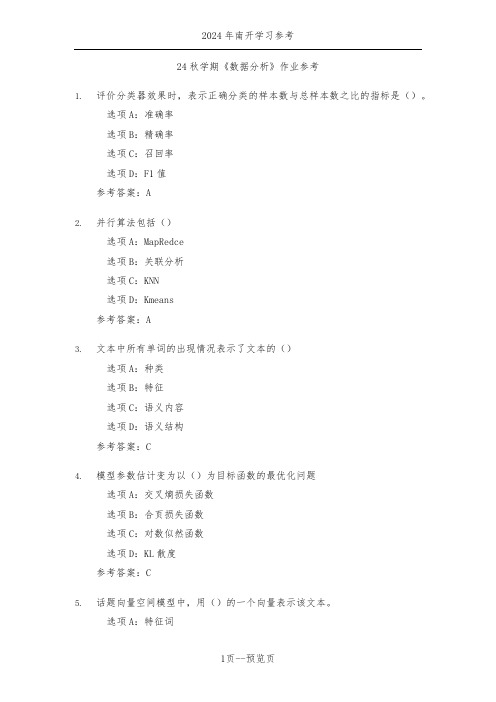
24秋学期《数据分析》作业参考1.评价分类器效果时,表示正确分类的样本数与总样本数之比的指标是()。
选项A:准确率选项B:精确率选项C:召回率选项D:F1值参考答案:A2.并行算法包括()选项A:MapRedce选项B:关联分析选项C:KNN选项D:Kmeans参考答案:A3.文本中所有单词的出现情况表示了文本的()选项A:种类选项B:特征选项C:语义内容选项D:语义结构参考答案:C4.模型参数估计变为以()为目标函数的最优化问题选项A:交叉熵损失函数选项B:合页损失函数选项C:对数似然函数选项D:KL散度参考答案:C5.话题向量空间模型中,用()的一个向量表示该文本。
选项A:特征词选项B:话题空间选项C:语义空间选项D:词向量空间参考答案:B6.经典的Apriori算法是逐层扫描的,也就是说它是()优先的选项A:宽度选项B:深度参考答案:A7.为了计算中介度,必须计算所有边上()的数目。
选项A:所有路径选项B:最短路径选项C:结点入度选项D:节点出度参考答案:B8.数据产生方式变革中数据产生方式是被动的主要是来自哪个阶段()。
选项A:运营式系统阶段选项B:用户原创内容阶段选项C:感知式系统阶段参考答案:A9.向量空间模型中,用一个()表示语义选项A:向量选项B:特征选项C:数字选项D:距离参考答案:A10.逻辑斯谛函数是一条()曲线选项A:抛物线。
2020-2021《算法分析》期末课程考试试卷(含答案)
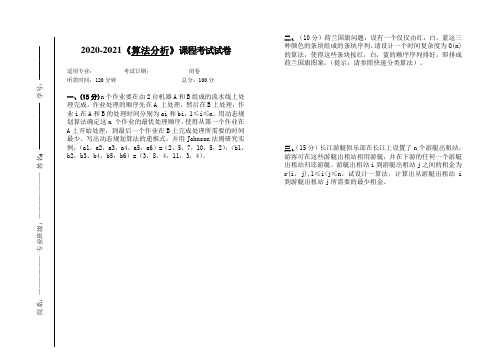
2020-2021《算法分析》课程考试试卷适用专业:考试日期:闭卷所需时间:120分钟总分:100分一、(15分)n个作业要在由2台机器A和B组成的流水线上处理完成,作业处理的顺序先在A 上处理,然后在B上处理,作业i在A和B的处理时间分别为ai和bi,1≤i≤n。
用动态规划算法确定这n 个作业的最优处理顺序,使得从第一个作业在A上开始处理,到最后一个作业在B上完成处理所需要的时间最少。
写出动态规划算法的递推式,并用Johnson法则研究实例:(a1,a2,a3,a4,a5,a6)=(2,5,7,10,5,2),(b1,b2,b3,b4,b5,b6)=(3,8,4,11,3,4)。
二、(10分)荷兰国旗问题:设有一个仅仅由红,白,蓝这三种颜色的条块组成的条块序列。
请设计一个时间复杂度为O(n)的算法,使得这些条块按红,白,蓝的顺序序列排好,即排成荷兰国旗图案。
(提示:请参照快速分类算法)。
三、(15分)长江游艇俱乐部在长江上设置了n个游艇出租站,游客可在这些游艇出租站租用游艇,并在下游的任何一个游艇出租站归还游艇。
游艇出租站i到游艇出租站j之间的租金为r(i,j),1≤i<j≤n。
试设计一算法,计算出从游艇出租站i 到游艇出租站j所需要的最少租金。
四、删数问题(15分)键盘输入一个高精度的正整数N,去掉其中任意S个数字后剩下的数字按原左右次序组成一个新的正整数。
对给定的N和S,寻找一种用贪心法方案使得剩下的数字组成的新数最小。
(N 不超过240位)五、(15分)整数变换问题:关于整数i的变换f和g的定义如下:f(i)=3i;g(i)=[i/2].试设计一算法,对于任意给定两个整数n和m,用最少的f和g变换次数将整数n变换为m。
当整数n 不可能变换为整数m时,算法如何处理?(要求描述出剪支函数)六、(15分)格雷码问题一个长度为2n的序列,满足:(1)、每个元素的都是长度为n比特的串。
(2)、序列中无相同的元素。
北语18秋《算法与数据分析》作业1234满分答案
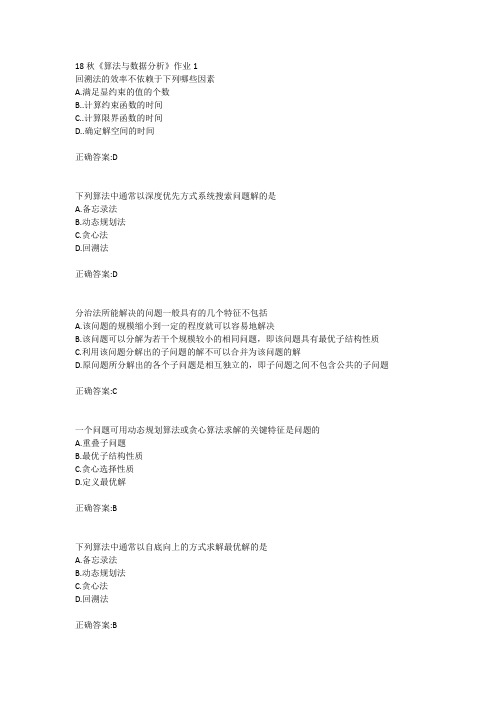
18秋《算法与数据分析》作业1回溯法的效率不依赖于下列哪些因素A.满足显约束的值的个数B..计算约束函数的时间C..计算限界函数的时间D..确定解空间的时间正确答案:D下列算法中通常以深度优先方式系统搜索问题解的是A.备忘录法B.动态规划法C.贪心法D.回溯法正确答案:D分治法所能解决的问题一般具有的几个特征不包括A.该问题的规模缩小到一定的程度就可以容易地解决B.该问题可以分解为若干个规模较小的相同问题,即该问题具有最优子结构性质C.利用该问题分解出的子问题的解不可以合并为该问题的解D.原问题所分解出的各个子问题是相互独立的,即子问题之间不包含公共的子问题正确答案:C一个问题可用动态规划算法或贪心算法求解的关键特征是问题的A.重叠子问题B.最优子结构性质C.贪心选择性质D.定义最优解正确答案:B下列算法中通常以自底向上的方式求解最优解的是A.备忘录法B.动态规划法C.贪心法D.回溯法正确答案:B在下列算法中有时找不到问题解的是A.蒙特卡罗算法B.拉斯维加斯算法C.舍伍德算法D.数值概率算法正确答案:B矩阵连乘问题的算法可由什么设计实现A.分支界限算法B.动态规划算法C.贪心算法D.回溯算法正确答案:B贪心算法与动态规划算法的共同点是A.重叠子问题B.构造最优解C.贪心选择性质D.最优子结构性质正确答案:D下列是动态规划算法基本要素的是A.定义最优解B.构造最优解C.算出最优解D.子问题重叠性质正确答案:D下面哪种函数是回溯法中为避免无效搜索采取的策略A.递归函数B..剪枝函数C.。
随机数函数D..搜索函数正确答案:B贪心选择性质是贪心算法可行的第一个基本要素,但不是贪心算法与动态规划算法的主要区别A.错误B.正确正确答案:A优先队列式分支限界法是指按照优先队列中规定的优先级选取优先级最高的节点成为当前扩展节点A.错误B.正确正确答案:B矩阵连乘问题的算法可由动态规划设计实现A.错误B.正确正确答案:B分治法与动态规划法的不同点是:适合于用动态规划法求解的问题,经分解得到的子问题往往不是互相独立的。
《第4课算法中的数据》作业设计方案-小学信息技术浙教版23五年级上册
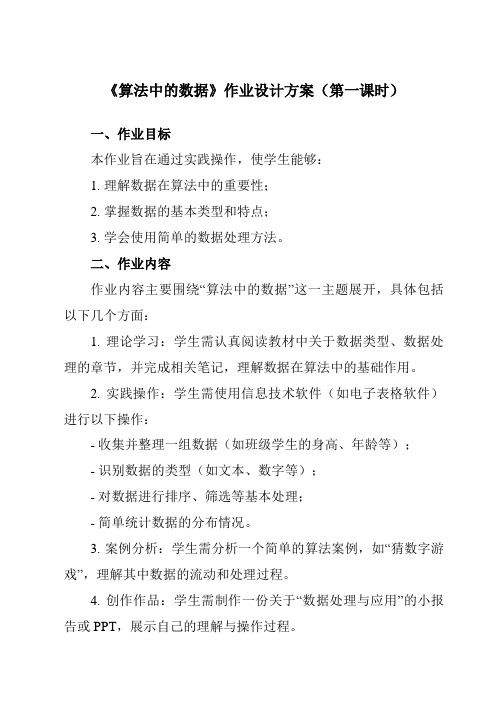
《算法中的数据》作业设计方案(第一课时)一、作业目标本作业旨在通过实践操作,使学生能够:1. 理解数据在算法中的重要性;2. 掌握数据的基本类型和特点;3. 学会使用简单的数据处理方法。
二、作业内容作业内容主要围绕“算法中的数据”这一主题展开,具体包括以下几个方面:1. 理论学习:学生需认真阅读教材中关于数据类型、数据处理的章节,并完成相关笔记,理解数据在算法中的基础作用。
2. 实践操作:学生需使用信息技术软件(如电子表格软件)进行以下操作:- 收集并整理一组数据(如班级学生的身高、年龄等);- 识别数据的类型(如文本、数字等);- 对数据进行排序、筛选等基本处理;- 简单统计数据的分布情况。
3. 案例分析:学生需分析一个简单的算法案例,如“猜数字游戏”,理解其中数据的流动和处理过程。
4. 创作作品:学生需制作一份关于“数据处理与应用”的小报告或PPT,展示自己的理解与操作过程。
三、作业要求1. 理论学习部分要求学生在教材上做好笔记,并能够用自己的语言解释数据在算法中的作用。
2. 实践操作部分要求学生亲自上机操作,并保存好操作过程记录和最终结果。
3. 案例分析部分要求学生仔细阅读案例,分析其中数据的处理流程,并能够复述给别人听。
4. 创作作品部分要求内容清晰、条理分明,能够展示学生对数据处理的全过程的理解。
四、作业评价1. 教师将根据学生的理论学习笔记,评价学生对数据概念的理解程度。
2. 通过学生的实践操作记录和最终结果,评价学生的实际操作能力和对软件使用的熟练程度。
3. 通过学生的案例分析报告,评价学生对数据处理流程的理解程度。
4. 根据学生的创作作品,评价其综合运用所学知识的能力和表达能力。
五、作业反馈1. 教师将在课堂上对学生的作业进行点评,指出优点和不足。
2. 对于普遍存在的问题,教师将进行集中讲解和指导。
3. 学生可根据教师的反馈,对自己的作业进行修改和完善。
4. 教师将对学生的作业成绩进行记录,作为学期末综合评价的依据之一。
东北师范大学奥鹏算法分析与设计20春在线作业2标准答案
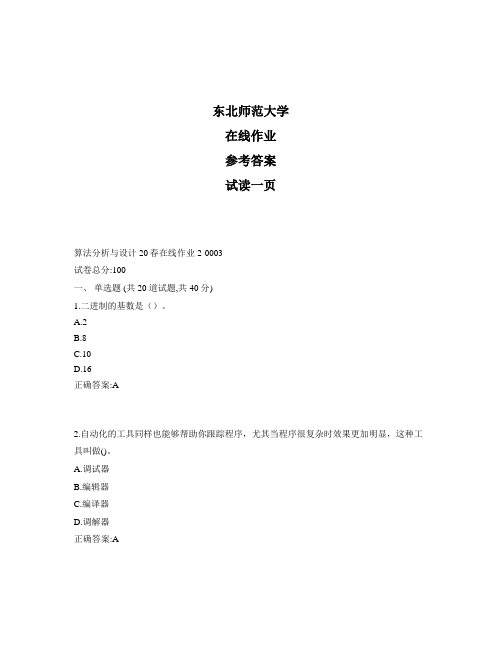
D.调解器
正确答案:A
3.int atoi(char *s)函数的作用是()。
A.整数转换为字符串
B.字符串转换为整数
C.字符转换为字符串
D.获取字符个数
正确答案:B
4.下列排序算法中,其中()是稳定的。
A.堆排序,冒泡排序
B.快速排序,堆排序
C.直接选择排序,归并排序
D.归并排序,冒泡排序
B.递归策略
C.递归出口
D.递归返回
正确答案:C
16.“二分法”和“牛顿迭代法”属于()。
A.递推法
B.穷举法
C.近似迭代法
D.动态规划法
正确答案:C
17.一个算法的评价主要从时间复杂度和()来考虑。
A.空间复杂度
B.算法有效性
C.算法有穷性
D.算法可读性
正确答案:A
18.下面关于二分查找的叙述正确的是()
A.VS
B.VM
C.Dev-C++
D.IDE
正确答案:A
8.下面4句话中,最准确的表述是()。
A.程序=算法+数据结构
B.程序是使用编程语言实现算法
C.程序的开发方法决定算法设计
D.算法是程序设计中最关键的因素
正确答案:A
9.执行memset(s,'a',4)后,s的值为()。
A."aaaa"
B."a4"
按“先进后出”原则组织数据的数据结构是队列。
A.错误
B.正确
正确答案:A
6.一个算法有零个或多个输入。
A.错误
B.正确
正确答案:B
7.算法的空间复杂度是指算法需要消耗的空间资源。
201809考试批次《算法与数据分析》(结课作业)

201809考试批次《算法与数据分析》结课作业学生姓名学习中心学号专业年级层次北京语言大学网络教育学院《算法与数据分析》结课作业注意:本学期所布置的结课作业,请同学一律按照以下要求执行:1) 结课作业提交起止时间:2018年8月1日--9月10日。
(届时平台自动关闭,逾期不予接收。
)2) 结课作业课程均需通过“离线作业”栏目提交电子版,学院不收取纸介的结课作业,以纸介回寄的作业一律视为无效;3)截止日期前可多次提交,平台只保留最后一次提交的文档,阅卷时以最后一次提交的结课作业为准,截止日期过后将关闭平台,逾期不交或科目提交错误者,按0分处理;4) 提交文档要求:提交的文档格式为doc、rar,大小10M以内;5) 必须严格按照每门课程的答题要求完成作业,没有按照学院要求来做的结课作业,将酌情扣分。
一. 论述题(本大题共5小题,请任选其中两道题作答,每小题25分,总分50分)1、试述分治法的基本思想。
2、设计动态规划算法有哪些主要步骤。
答:( 1)找出最优解的性质,并刻划其结构特征。
( 2)递归地定义最优值。
(3)以自底向上的方式计算出最优值。
(4)根据计算最优值时得到的信息,构造最优解。
3、分治法与动态规划法的异同?答:分治法与动态规划法的相同点是:将待求解的问题分解成若干个子问题,先求解子问题,然后从这些子问题的解得到原问题的解。
两者的不同点是:适合于用动态规划法求解的问题,经分解得到的子问题往往不是互相独立的。
而用分治法求解的问题,经分解得到的子问题往往是互相独立的。
4、比较分支限界法与回溯法的异同?5、写出回溯法搜索子集树的算法。
二. 算法设计题(本大题5小题,请任选其中两道题作答,每小题25分,总分50分)1、背包问题的贪心算法。
2、最大子段和: 动态规划算法。
答:一般理论最大子段和问题复杂度为O(n)的解法,在上篇博客最大连续子序列中已经谈过了。
这里在稍微提及一下,主要是更形式化的说明为什么是用动态规划。
《数据结构与算法分析课程设计》任务书 (2)
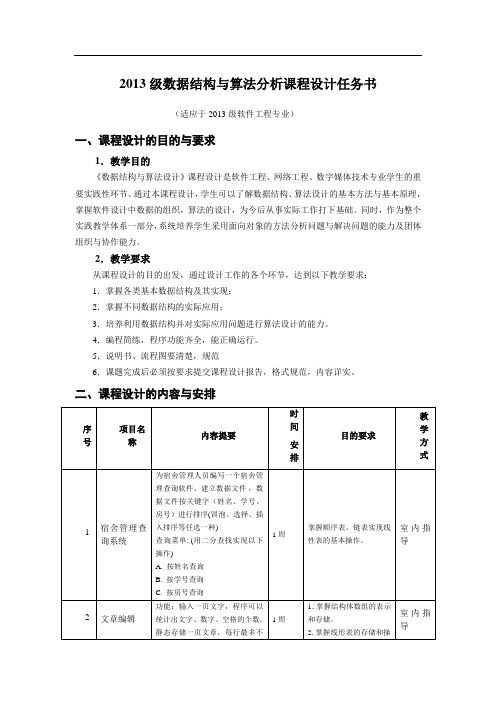
2013级数据结构与算法分析课程设计任务书(适应于2013级软件工程专业)一、课程设计的目的与要求1.教学目的《数据结构与算法设计》课程设计是软件工程、网络工程、数字媒体技术专业学生的重要实践性环节。
通过本课程设计,学生可以了解数据结构、算法设计的基本方法与基本原理,掌握软件设计中数据的组织,算法的设计,为今后从事实际工作打下基础。
同时,作为整个实践教学体系一部分,系统培养学生采用面向对象的方法分析问题与解决问题的能力及团体组织与协作能力。
2.教学要求从课程设计的目的出发,通过设计工作的各个环节,达到以下教学要求:1.掌握各类基本数据结构及其实现;2.掌握不同数据结构的实际应用;3.培养利用数据结构并对实际应用问题进行算法设计的能力。
4.编程简练,程序功能齐全,能正确运行。
5.说明书、流程图要清楚,规范6.课题完成后必须按要求提交课程设计报告,格式规范,内容详实。
二、课程设计的内容与安排注:1、鼓励各位同学自主查找资料,结合专业特性,尽量应用图形界面实现,以期对图形界面的开发有一个比较深入的了解。
2、任务要求1.问题分析和任务定义。
根据设计题目的要求,充分地分析和理解问题,明确问题要求做什么?(而不是怎么做?)限制条件是什么?2.逻辑设计。
对问题描述中涉及的操作对象定义相应的数据类型,并按照以数据结构为中心的原则划分模块,定义主程序模块和各抽象数据类型。
逻辑设计的结果应写出每个抽象数据类型的定义(包括数据结构的描述和每个基本操作的功能说明),各个主要模块的算法,并画出模块之间的调用关系图。
3.详细设计。
定义相应的存储结构并写出各函数的伪码算法。
在这个过程中,要综合考虑系统功能,使得系统结构清晰、合理、简单和易于调试,抽象数据类型的实现尽可能做到数据封装,基本操作的规格说明尽可能明确具体。
详细设计的结果是对数据结构和基本操作作出进一步的求精,写出数据存储结构的类型定义,写出函数形式的算法框架。
4.程序编码。
- 1、下载文档前请自行甄别文档内容的完整性,平台不提供额外的编辑、内容补充、找答案等附加服务。
- 2、"仅部分预览"的文档,不可在线预览部分如存在完整性等问题,可反馈申请退款(可完整预览的文档不适用该条件!)。
- 3、如文档侵犯您的权益,请联系客服反馈,我们会尽快为您处理(人工客服工作时间:9:00-18:30)。
20秋《算法与数据分析》作业2
采用贪心算法的最优装载问题的主要计算量在于将集装箱依其重量从小到大排序,故算法的时间复杂度为
A:O(n2n)
B:O(nlogn)
C:O(2n)
D:O(n)
答案:B
在下列算法中有时找不到问题解的是
A:蒙特卡罗算法
B:拉斯维加斯算法
C:舍伍德算法
D:数值概率算法
答案:B
最长公共子序列算法利用的算法是
A:分支界限法
B:动态规划法
C:贪心法
D:回溯法
答案:B
下列算法中通常以深度优先方式系统搜索问题解的是A:备忘录法
B:动态规划法
C:贪心法
D:回溯法
答案:D
Strassen矩阵乘法是利用什么实现的算法
A:分治策略
B:动态规划法
C:贪心法
D:回溯法
答案:A
以深度优先方式系统搜索问题解的算法称为
A:分支界限算法。
